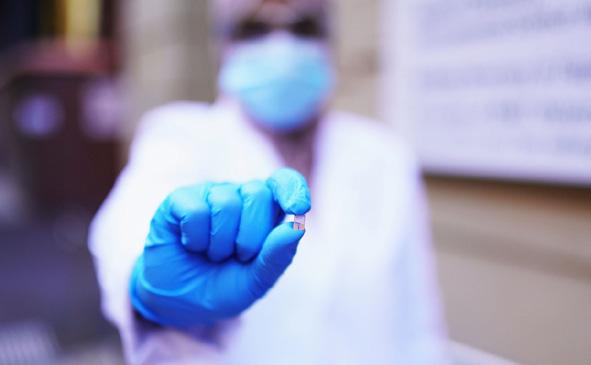
3 minute read
New Butterfly-Inspired Hydrogen Sensor Is Powered By Light
Source: Sally Wood
Inspired by the surface of butterfly wings, researchers have developed a light-activated hydrogen sensor that produces ultra-precise results at room temperature.
The technology can detect hydrogen leaks well before they pose safety risks and can measure tiny amounts of the gas on people’s breath, for diagnosing gut disorders. The sensor, which is based on the bumpy microstructures that imitate the surface of butterfly wings, is detailed in a new study published in the journal ACS Sensors. Researcher Dr Ylias Sabri at RMIT University said the prototype was scalable, cost-effective and offered a total package of features that could not be matched by any hydrogen sensor currently on the market. “Some sensors can measure tiny amounts, others can detect larger concentrations; they all need a lot of heat to work. “Our hydrogen sensor can do it all - it’s sensitive, selective, works at room temperature and can detect across a full range of levels,” Dr Sabri said. The sensor can detect hydrogen at concentrations from as little as ten parts per million molecules (for medical diagnoses) to 40,000 parts per million – the level where the gas becomes potentially explosive. Co-lead researcher Dr Ahmad Kandjani said the broad detection range made it ideal for both medical use and to enhance safety in the emerging hydrogen economy. “Hydrogen has potential to be the fuel of the future but we know safety fears could affect public confidence in this renewable energy source. “By delivering precise and reliable sensing technology that can detect the tiniest of leaks, well before they become dangerous, we hope to contribute to advancing a hydrogen economy that can transform energy supplies around the world,” he added. The innovative core of the new sensor is made up of tiny spheres known as photonic or colloidal crystals. These hollow shapes – similar to the miniscule bumps found on the surface of butterfly wings – are highly ordered structures that are ultra-efficient at absorbing light. This allows the sensor to draw on the energy it needs to operate from a beam of light, rather than from heat. An electronic chip is first covered with a thin layer of photonic crystals and then with a titanium palladium composite. When hydrogen interacts with the chip, the gas is converted into water. This process creates an electronic current, and by measuring the magnitude of the current, the sensor can tell precisely how much hydrogen is present. The technology is highly selective so it can accurately isolate hydrogen from other gases. The breakthrough could have wide applications in the medical industry, particularly in diagnosis and monitoring, as elevated levels of hydrogen are known to be connected to gastrointestinal disorders. The standard diagnostic approach is typically completed through breath samples, which are sent to labs for processing. Dr Sabri said the new chip could be integrated into a hand-held device to deliver instant results. “With gut conditions, the difference between healthy levels of hydrogen and unhealthy levels is miniscule – just ten parts per million - but our sensor can accurately measure such tiny differences,” he said. A provisional patent application has been filed for the technology and the research team hopes to collaborate with manufacturers of hydrogen sensors, fuel cells, batteries or medical diagnostic companies to commercialise the sensor. The new study is the culmination of over a two decade investigation into gas sensing by researchers at RMIT’s Centre for Advanced Materials and Industrial Chemistry, led by Distinguished Professor Suresh Bhargava. Professor Bhargava said Ebtsam Alenezy, an international PhD student who came to RMIT from Saudi Arabia’s Al Jouf University in 2017, had set a high benchmark with her research.
“Ebtsam is an inspirational role model for aspiring scientists. She has been an important contributor to the crossdisciplinary CAMIC team,” he said.


Top: PhD researcher Ebtsam Alenezy holds a prototype of the light-activated hydrogen sensor, which can deliver ultra-precise results at room temperature. Image credit: RMIT University. Middle Left: The sensor is made with an electronic chip, which is covered with a thin layer of photonic crystals and then a titanium palladium composite. Image credit: RMIT University. Bottom: These tiny hollow spheres known as photonic crystals, inspired by the bumpy surface of butterfly wings, are the innovative core of the new hydrogen sensor. Image magnified 40,000 times. Image credit: RMIT University.










